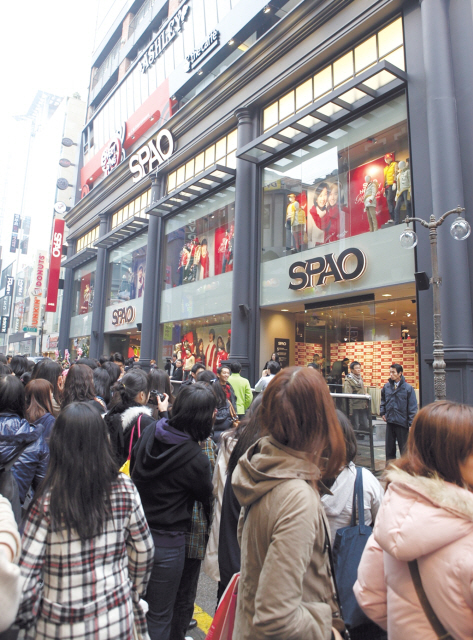Japan’s Uniqlo, Spain’s Zara and Sweden’s H&M have for years enjoyed huge sales to the point of dealing a blow to most other casual brands here.
Sales of such global fast fashion brands have grown 56 percent annually on average over the past three years in Korea.
By designing and manufacturing quickly and cheaply based on the latest trends presented at Fashion Week, these specialty store retailers of private-label apparel have led a major transition in the clothing retail industry.
They have improved quality over the years, and entered department stores, road shops and large shopping malls.
Hollister came in last year and Mango re-launched this year, while Primark and Topshop are tapping the local market.
Last year, the Korean market size of global SPA brands amounted to 2.4 trillion won, up 30 percent from 2011, according to Samsung Fashion Research Institute.
As the multinational fast fashion labels continue to thrive, several homegrown SPA brands have thrown down the gauntlet.
Cheil Industries Inc. unveiled 8ight Seconds last year, and met its annual sales target of 60 billion won from the 14 stores it opened.
“With Cheil having led the Korean fashion industry for decades, we believe we know the local consumers’ tastes best and can respond faster to market changes here compared to global brands,” said Yang Hee-joon, spokesman for Cheil.
“In contrast to global brands’ standardized manuals, we plan to build our brand through distinguished cultural content and styles that suit the shopping patterns and lifestyles of each store’s location. It is our goal to make 8eight Seconds stores the cultural landmarks of each neighborhood.”
8ight Seconds offers the perfect fit for Koreans in addition to basic lines and quality comparable to Uniqlo as well as creative designs that rival Zara and H&M, Yang said.
With price ranges matching that of both Uniqlo and Zara, the homegrown label has more loungewear and accessory lines than other SPA brands.
It also collaborates with dozens of young, up and coming designers by printing their illustrations on T-shirts or selling their products in its stores.
 |
An 8ight Seconds store |
This year, 8eight Seconds plans to open 10 more stores and reach over 200 billion won in sales.
The new brand expects to break even in the last quarter of this year and enter the Chinese market next year.
Its sales targets for 2020 are 1.2 trillion won in China and 800 billion won in Korea.
Another local SPA brand Spao of E-Land Retail launched in 2010.
Spao’s sales more than doubled in two years to more than 100 billion won last year.
 |
A Spao store |
“The most important thing in a SPA brand is the system ― for distribution as well as getting the best supply of yarns,” said Hwang Woo-il, spokesman of E-Land Retail.
“Having started the fashion business in 1980, E-Land has accumulated a great deal of technological know-how in addition to some 1,000 designers. These are Spao’s main strengths.”
Spao is 10 to 20 percent cheaper than global SPA brands, and fits Koreans better, according to Hwang.
“Zara and H&M used to be more popular before, but after they launched in Korea, many consumers complained about their fitting and prices which were higher than in other markets,” he said.
This year, E-Land plans to take Spao to China, where it already sells about 30 apparel brands.
In addition to the casual brand similar to Uniqlo, E-Land also has women’s wear label Mixxo, which sells blouses and skirts like Zara, and WHO.A.U, which started releasing new products every two weeks.
Korea also has Codes Combine, which has grown steadily since 2002 with chic, modern designs and toned down colors.
The company Codes Combine has about 10 sub-brands under the single label such as Codes Combine Women, Men, Codes Combine New York and Codes Combine C-Code.
All of these are sold in what look like multi-shops directly run by the company.
“The most distinct feature of a SPA brand is the fast turnover of merchandise. Whereas large companies in Korea release new collections twice or four times a year, we do it once in a month or two,” said a Code Combine official.
The brand’s revenue grew much more quickly in the beginning, but slowed recently to 203 billion won last year. It launched in China in 2007, but saw annual sales of only around 10 billion won.
Code Combine plans to expand its distribution channels in China and shift from department stores to more directly-run shops at home.
By Kim So-hyun (
sophie@heraldcorp.com)









